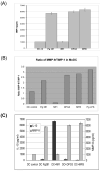MMP-9/TIMP-1 imbalance induced in human dendritic cells by Porphyromonas gingivalis
- PMID: 20030715
- PMCID: PMC2871062
- DOI: 10.1111/j.1574-695X.2009.00637.x
MMP-9/TIMP-1 imbalance induced in human dendritic cells by Porphyromonas gingivalis
Abstract
Matrix metalloproteinase-9 (MMP-9) cleaves collagen, allowing leukocytes to traffic toward the vasculature and the lymphatics. When MMP-9 is unregulated by tissue inhibitor of metalloproteinase-1 (TIMP-1), this can lead to tissue destruction. Dendritic cells (DCs) infiltrate the oral mucosa increasingly in chronic periodontitis, characterized by infection with several pathogens including Porphyromonas gingivalis. In this study, human monocyte-derived DCs were pulsed with different doses of lipopolysaccharide of P. gingivalis 381 and of Escherichia coli type strain 25922, as well as whole live isogenic fimbriae-deficient mutant strains of P. gingivalis 381. Levels of induction of MMP-9 and TIMP-1, as well as interleukin-10 (IL-10), which reportedly inhibits MMP-9 induction, were measured by several approaches. Our results reveal that lipopolysaccharide of P. gingivalis, compared with lipopolysaccharide from E. coli type strain 25922, is a relatively potent inducer of MMP-9, but a weak inducer of TIMP-1, contributing to a high MMP-9/TIMP-1 ratio.Whole live P. gingivalis strain 381, major fimbriae mutant DPG-3 and double mutant MFB were potent inducers of MMP-9, but minor fimbriae mutant MFI was not. MMP-9 induction was inversely proportional to IL-10 induction. These results suggest that lipopolysaccharide and the minor and the major fimbriae of P. gingivalis may play distinct roles in induction by DCs of MMP-9, a potent mediator of local tissue destruction and leukocyte trafficking.
Figures



References
-
- Bode W, Fernandez-Catalan C, Nagase H, Maskos K. Endoproteinase-protein inhibitor interactions. APMIS. 1999;107:3–10. - PubMed
-
- Cario E. Barrier-protective function of intestinal epithelial Toll-like receptor 2. Mucosal Immunol. 2008;1(Suppl 1):S62–66. - PubMed
-
- Cazalis J, Tanabe S, Gagnon G, Sorsa T, Grenier D. Tetracyclines and chemically modified tetracycline-3 (CMT-3) modulate cytokine secretion by lipopolysaccharide-stimulated whole blood. Inflammation. 2009;32:130–137. - PubMed
Publication types
MeSH terms
Substances
Grants and funding
LinkOut - more resources
Full Text Sources
Other Literature Sources
Research Materials
Miscellaneous
